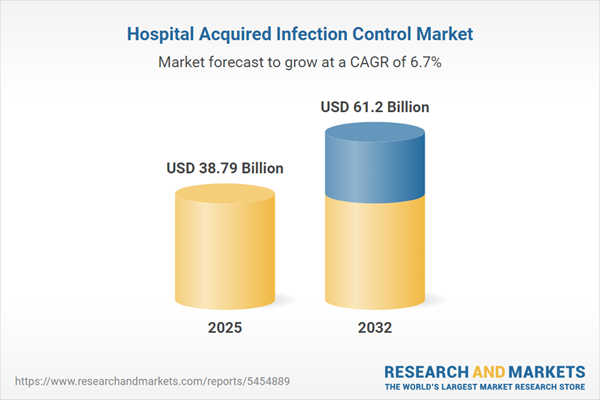Speak directly to the analyst to clarify any post sales queries you may have.
Senior leaders in healthcare are driving fundamental change by prioritizing hospital acquired infection control as a strategic foundation for safety, compliance, and operational excellence. By adopting forward-looking technologies and fostering cross-functional alignment, organizations can proactively safeguard patient outcomes and build long-term system resilience.
Market Snapshot: Hospital Acquired Infection Control Market
In 2024, the Hospital Acquired Infection Control Market reached a valuation of USD 36.39 billion, with projections indicating an increase to USD 38.79 billion by 2025 and further expansion to USD 61.20 billion by 2032. Supported by a compound annual growth rate (CAGR) of 6.71 percent, this sustained upward trend highlights the growing importance of infection prevention across all healthcare settings. Organizations are incorporating advanced infection control technology and adopting digital surveillance to remain aligned with evolving compliance standards. These changes are reinforcing sector-wide collaboration, encouraging process transparency, and supporting consistent infection mitigation in both acute and ambulatory environments.
Scope & Segmentation
- Product Types: Air purification systems with HEPA and UV-based filtration are deployed to target airborne pathogens. Antimicrobial coatings are applied on frequently touched equipment and surfaces to support extended contamination resistance. Hand hygiene products such as gels and wipes are embedded into clinical routines, directly safeguarding high-contact areas. Sterilization systems, utilizing methods including steam, ethylene oxide, and vaporized hydrogen peroxide, are fundamental for device and tool safety. Surface disinfectants—formulated with agents like chlorine, alcohol, peroxygen, or quaternary ammonium compounds—enforce rigorous sanitation protocols. Ultraviolet disinfection tools deliver targeted microbial reduction in critical care zones, while water treatment platforms secure clean supply for clinical procedures.
- Application Environments: Infection control solutions are integrated across emergency departments, intensive care units, hospital wards, operating suites, ambulatory clinics, pediatric domains, and specialty treatment centers. Each care setting presents specific risks and requires solutions tailored for the workflow, patient acuity, and infectious threat profile unique to that environment.
- Regional Coverage: In the Americas, procurement strategies emphasize adaptability amid complex regulatory demands and shifting health emergencies. EMEA encompasses well-established Western European protocols alongside the Middle East and Africa, where evolving legislation often drives sector investment and innovation. Asia-Pacific markets experience continuous modernization, with countries such as China, India, Japan, Australia, and South Korea advancing infection prevention through rapid expansion of technology adoption and policy refinement.
- Key Companies: The competitive landscape is shaped by organizations including Ecolab Inc., 3M Company, Danaher Corporation, STERIS plc, Getinge AB, Johnson & Johnson, Cardinal Health, B. Braun Melsungen AG, Mölnlycke Health Care AB, and Ansell Limited. Their efforts focus on integrating digital solutions and process improvements to advance industry benchmarks.
Key Takeaways for Senior Decision-Makers
- Investing in digital infrastructure, such as advanced monitoring and cloud-based hygiene protocols, elevates organizational readiness and enhances real-time decision capability.
- Aligning procurement with up-to-date regulatory intelligence enables supply assurance and risk mitigation, which are vital during operational fluctuations or supply chain disturbances.
- Deploying IoT-enabled systems for environmental and sterilization monitoring helps standardize infection control and supports consistent regulatory adherence across multiple sites.
- Fostering collaboration among executive, clinician, and supplier groups leads to integrated infection prevention programs that boost operational efficiency and outcome consistency.
- Building adaptable procurement frameworks ensures resource continuity even as compliance and regulatory standards change, reducing rate of supply interruptions.
- Modular, outcome-based strategies allow healthcare providers to maintain care quality in periods of resource constraint or rapid operational change.
Tariff Impact on Infection Control Product Supply Chains
Recent US tariffs on stainless steel and electronic components have led to increased operational costs in the infection control product supply chain. To buffer against volatility and supply disruptions, purchasing teams are broadening supplier networks, adopting nearshore manufacturing models, and developing strategic provider relationships. These steps are helping to maintain product availability, promote standardization, and improve overall resilience in the face of evolving economic and regulatory conditions.
Methodology & Data Sources
This assessment draws on structured interviews with practitioners, continuous regulatory tracking, and insights from infection control and procurement experts. Data validity is ensured through triangulation with trusted industry sources, providing senior executives with practical, actionable recommendations for their infection control strategies.
Why This Report Matters for Infection Control Leadership
- Segment-driven analysis enables leaders to prioritize high-impact investments, directing capital to solutions with clear preventive value.
- Structured guidance for technology integration and compliance supports agile procurement and strengthens organizations' capacity to adjust for future operational changes.
- Practical strategies refined in this report empower decision-makers to continuously improve infection control procedures, supporting both patient safety and institutional compliance objectives.
Conclusion
Strengthening infection control leadership means prioritizing adaptability, standardized processes, and ongoing investment in new technologies. These advances collectively support safer environments and foster lasting resilience across the healthcare industry.
Additional Product Information:
- Purchase of this report includes 1 year online access with quarterly updates.
- This report can be updated on request. Please contact our Customer Experience team using the Ask a Question widget on our website.
Table of Contents
3. Executive Summary
4. Market Overview
7. Cumulative Impact of Artificial Intelligence 2025
Companies Mentioned
The companies profiled in this Hospital Acquired Infection Control market report include:- Ecolab Inc.
- 3M Company
- Danaher Corporation
- STERIS PLC
- Getinge AB
- Johnson & Johnson
- Cardinal Health, Inc.
- B. Braun Melsungen AG
- Mölnlycke Health Care AB
- Ansell Limited
Table Information
| Report Attribute | Details |
|---|---|
| No. of Pages | 190 |
| Published | November 2025 |
| Forecast Period | 2025 - 2032 |
| Estimated Market Value ( USD | $ 38.79 Billion |
| Forecasted Market Value ( USD | $ 61.2 Billion |
| Compound Annual Growth Rate | 6.7% |
| Regions Covered | Global |
| No. of Companies Mentioned | 11 |









